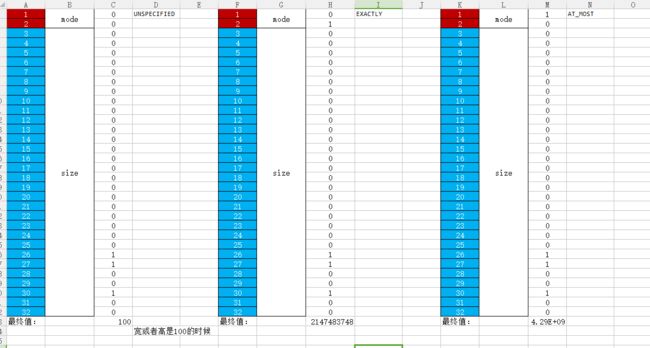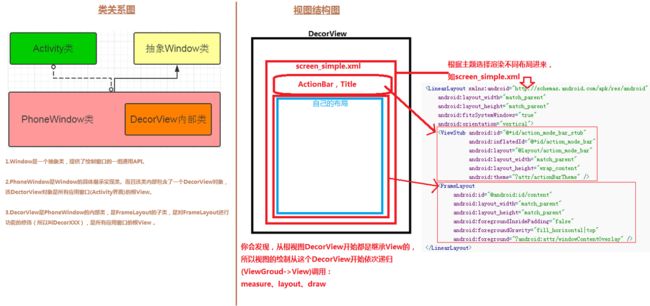前言
上一次我们讲到最基本的android运行流程和绘制流程的调用顺序,那么我们最终得到的一个结论是activity的生命周期是有系统服务所触发,由系统服务发起handle调用到handleResumeActivity()开始绘制流程然后最终交由ViewRootImpl调用到performTraversals()
然后依次之行了我们UI的实际绘制流程measure(测量),layout(布局摆放),Draw(具体绘制)
那么今天我们需要了解的是对UI具体的绘制流程measure,layout,Draw进行深入分析,并且依托于今天所学内容完成自定义瀑布流式布局
1.View的测量
首先我们找到了绘制流程当中performTraversals()的测量布局方法
if (!mStopped || mReportNextDraw) {
boolean focusChangedDueToTouchMode = ensureTouchModeLocally(
(relayoutResult&WindowManagerGlobal.RELAYOUT_RES_IN_TOUCH_MODE) != 0);
if (focusChangedDueToTouchMode || mWidth != host.getMeasuredWidth()
|| mHeight != host.getMeasuredHeight() || contentInsetsChanged ||
updatedConfiguration) {
int childWidthMeasureSpec = getRootMeasureSpec(mWidth, lp.width);
int childHeightMeasureSpec = getRootMeasureSpec(mHeight, lp.height);
if (DEBUG_LAYOUT) Log.v(mTag, "Ooops, something changed! mWidth="
+ mWidth + " measuredWidth=" + host.getMeasuredWidth()
+ " mHeight=" + mHeight
+ " measuredHeight=" + host.getMeasuredHeight()
+ " coveredInsetsChanged=" + contentInsetsChanged);
// Ask host how big it wants to be
performMeasure(childWidthMeasureSpec, childHeightMeasureSpec);
// Implementation of weights from WindowManager.LayoutParams
// We just grow the dimensions as needed and re-measure if
// needs be
int width = host.getMeasuredWidth();
int height = host.getMeasuredHeight();
boolean measureAgain = false;
if (lp.horizontalWeight > 0.0f) {
width += (int) ((mWidth - width) * lp.horizontalWeight);
childWidthMeasureSpec = MeasureSpec.makeMeasureSpec(width,
MeasureSpec.EXACTLY);
measureAgain = true;
}
if (lp.verticalWeight > 0.0f) {
height += (int) ((mHeight - height) * lp.verticalWeight);
childHeightMeasureSpec = MeasureSpec.makeMeasureSpec(height,
MeasureSpec.EXACTLY);
measureAgain = true;
}
if (measureAgain) {
if (DEBUG_LAYOUT) Log.v(mTag,
"And hey let's measure once more: width=" + width
+ " height=" + height);
performMeasure(childWidthMeasureSpec, childHeightMeasureSpec);
}
layoutRequested = true;
}
}
performMeasure方法,在这里他与调用到的
private void performMeasure(int childWidthMeasureSpec, int childHeightMeasureSpec) {
if (mView == null) {
return;
}
Trace.traceBegin(Trace.TRACE_TAG_VIEW, "measure");
try {
mView.measure(childWidthMeasureSpec, childHeightMeasureSpec);
} finally {
Trace.traceEnd(Trace.TRACE_TAG_VIEW);
}
}
在这里我们可以看到当前他调用了view当中的测量
那么这里我门主要是对于测量方法当中的代码进行分析
在调用performMeasure调用之前需要两个参数
int childWidthMeasureSpec = getRootMeasureSpec(mWidth, lp.width);
int childHeightMeasureSpec = getRootMeasureSpec(mHeight, lp.height);
performMeasure(childWidthMeasureSpec, childHeightMeasureSpec);
他这里的意思是,传入宽高的测量规格,那么这个规格是什么意思?
那么进入到getRootMeasureSpec方法时我门会看到
private static int getRootMeasureSpec(int windowSize, int rootDimension) {
int measureSpec;
switch (rootDimension) {
case ViewGroup.LayoutParams.MATCH_PARENT:
// Window can't resize. Force root view to be windowSize.
measureSpec = MeasureSpec.makeMeasureSpec(windowSize, MeasureSpec.EXACTLY);
break;
case ViewGroup.LayoutParams.WRAP_CONTENT:
// Window can resize. Set max size for root view.
measureSpec = MeasureSpec.makeMeasureSpec(windowSize, MeasureSpec.AT_MOST);
break;
default:
// Window wants to be an exact size. Force root view to be that size.
measureSpec = MeasureSpec.makeMeasureSpec(rootDimension, MeasureSpec.EXACTLY);
break;
}
return measureSpec;
}
然后在这里我门看到了一个对象MeasureSpec
MeasureSpec的作用是在在Measure流程中,系统将View的LayoutParams根据父容器所施加的规则转换成对应的MeasureSpec(规格)
然后在onMeasure中根据这个MeasureSpec来确定view的测量宽高
这是我们打开MeasureSpec源码,在这中间我们会看到下面这几个方法
public static class MeasureSpec {
private static final int MODE_SHIFT = 30;
private static final int MODE_MASK = 0x3 << MODE_SHIFT;
/**
* UNSPECIFIED 模式:
* 父View不对子View有任何限制,子View需要多大就多大
*/
public static final int UNSPECIFIED = 0 << MODE_SHIFT;
/**
* EXACTYLY 模式:
* 父View已经测量出子Viwe所需要的精确大小,这时候View的最终大小
* 就是SpecSize所指定的值。对应于match_parent和精确数值这两种模式
*/
public static final int EXACTLY = 1 << MODE_SHIFT;
/**
* AT_MOST 模式:
* 子View的最终大小是父View指定的SpecSize值,并且子View的大小不能大于这个值,
* 即对应wrap_content这种模式
*/
public static final int AT_MOST = 2 << MODE_SHIFT;
//将size和mode打包成一个32位的int型数值
//高2位表示SpecMode,测量模式,低30位表示SpecSize,某种测量模式下的规格大小
public static int makeMeasureSpec(int size, int mode) {
if (sUseBrokenMakeMeasureSpec) {
return size + mode;
} else {
return (size & ~MODE_MASK) | (mode & MODE_MASK);
}
}
//将32位的MeasureSpec解包,返回SpecMode,测量模式
public static int getMode(int measureSpec) {
return (measureSpec & MODE_MASK);
}
//将32位的MeasureSpec解包,返回SpecSize,某种测量模式下的规格大小
public static int getSize(int measureSpec) {
return (measureSpec & ~MODE_MASK);
}
//...
}
测量模式
EXACTLY :父容器已经测量出所需要的精确大小,这也是childview的最终大小
------match_parent,精确值是爸爸的
ATMOST : child view最终的大小不能超过父容器的给的
------wrap_content 精确值不超过爸爸
UNSPECIFIED: 不确定,源码内部使用
-------一般在ScrollView,ListView
那么在此处我们可以看到, 在出我们测量方法当中他传递的并不是一个纯粹的size,而是遵循了我们设置宽高时的几种模式:EXACTLY ,ATMOST ,UNSPECIFIED这三个模式的本质是0,1,2的左位移30位,
那么其实我们先能理解为我们实际上在传递值得过程当中将显示模式+size打包一起交给measure方法
而里面的数据结构其实实际上是一个32位的数值,
我们可以明显看到几个模式的值在后面进行了左位移操作了30位
用MODE_SHIFT 操作之后,实际表明一个32位的值30前两位作为MODE
而MODE_MASK 表示是后30位
所以现在能得出一个结论他们的数据构可以看成是
而这个时候我们看到有三个方法负责打包解析
makeMeasureSpec--负责打包mode和size
getMode--负责解析得到mode部分
getSize--负责解析得到size部分
那么打包时运用了(size & ~MODE_MASK) | (mode & MODE_MASK)的算法进行混合,那么这里我们可以认为 是size 转化成32位后放入后30位 组合 mode(mode放入前两位)
getMode解析用了measureSpec & MODE_MASK(解析只要前2位)
getSize解析用了measureSpec & ~MODE_MASK(不要前两位)
那么此处就可以得到,在测量时他真正的给我传递的是规格,而所谓的规格只不过是显示模式+实际宽高的一个数据包,或者你理解为这个值当中包含模式和具体数值就行了
所以我们得出一个结论,View的测量流程中,通过makeMeasureSpec来保存宽高信息,在其他流程通过getMode或getSize得到模式和宽高。那么问题来了,上面提到MeasureSpec是子容器和父容器的模式所共同影响的,那么,对于DecorView来说,它已经是顶层view了,没有父容器,那么它的MeasureSpec怎么来的呢? 是否还记得我们的setContent所加载的系统布局?
我们的初始就已经给了一个布局去装载,所以,在这里,他的爸爸是系统布局
那么到目前为止,就已经获得了一份DecorView的MeasureSpec,它代表着根View的规格、尺寸,在接下来的measure流程中,就是根据已获得的根View的MeasureSpec来逐层测量各个子View。来到performMeasure方法,看看它做了什么工作
private void performMeasure(int childWidthMeasureSpec, int childHeightMeasureSpec) {
Trace.traceBegin(Trace.TRACE_TAG_VIEW, "measure");
try {
mView.measure(childWidthMeasureSpec, childHeightMeasureSpec);
} finally {
Trace.traceEnd(Trace.TRACE_TAG_VIEW);
}
}
这里很明显他直接调用搞得是view的measure这里的mView就是DecorView,也就是说,从顶级View开始了测量流程
public final void measure(int widthMeasureSpec, int heightMeasureSpec) {
boolean optical = isLayoutModeOptical(this);
if (optical != isLayoutModeOptical(mParent)) {
...
if ((mPrivateFlags & PFLAG_FORCE_LAYOUT) == PFLAG_FORCE_LAYOUT ||
widthMeasureSpec != mOldWidthMeasureSpec ||
heightMeasureSpec != mOldHeightMeasureSpec) {
...
if (cacheIndex < 0 || sIgnoreMeasureCache) {
// measure ourselves, this should set the measured dimension flag back
onMeasure(widthMeasureSpec, heightMeasureSpec);
mPrivateFlags3 &= ~PFLAG3_MEASURE_NEEDED_BEFORE_LAYOUT;
}
...
}
可以看到,它在内部调用了onMeasure方法所以这里开始调用onMeasure
那么注意,到此为止,我们的布局容器的核心就在这里了,
不管是LinearLayout或者是FreamLayout还是其他布局, 他们都是通过测量组件,实现我们的布局定位,每一个Layout的onMeasure实现都不一样,这里因为顶层是一个FreamLayout所以我们
参照FreamLayout作为案例
protected void onMeasure(int widthMeasureSpec, int heightMeasureSpec) {
//获取当前布局内的子View数量
int count = getChildCount();
//判断当前布局的宽高是否是match_parent模式或者指定一个精确的大小,如果是则置measureMatchParent为false.
final boolean measureMatchParentChildren =
MeasureSpec.getMode(widthMeasureSpec) != MeasureSpec.EXACTLY ||
MeasureSpec.getMode(heightMeasureSpec) != MeasureSpec.EXACTLY;
mMatchParentChildren.clear();
int maxHeight = 0;
int maxWidth = 0;
int childState = 0;
//遍历所有类型不为GONE的子View
for (int i = 0; i < count; i++) {
final View child = getChildAt(i);
if (mMeasureAllChildren || child.getVisibility() != GONE) {
//对每一个子View进行测量
measureChildWithMargins(child, widthMeasureSpec, 0, heightMeasureSpec, 0);
final LayoutParams lp = (LayoutParams) child.getLayoutParams();
//寻找子View中宽高的最大者,因为如果FrameLayout是wrap_content属性
//那么它的大小取决于子View中的最大者
maxWidth = Math.max(maxWidth,
child.getMeasuredWidth() + lp.leftMargin + lp.rightMargin);
maxHeight = Math.max(maxHeight,
child.getMeasuredHeight() + lp.topMargin + lp.bottomMargin);
childState = combineMeasuredStates(childState, child.getMeasuredState());
//如果FrameLayout是wrap_content模式,那么往mMatchParentChildren中添加
//宽或者高为match_parent的子View,因为该子View的最终测量大小会受到FrameLayout的最终测量大小影响
if (measureMatchParentChildren) {
if (lp.width == LayoutParams.MATCH_PARENT ||
lp.height == LayoutParams.MATCH_PARENT) {
mMatchParentChildren.add(child);
}
}
}
}
// Account for padding too
maxWidth += getPaddingLeftWithForeground() + getPaddingRightWithForeground();
maxHeight += getPaddingTopWithForeground() + getPaddingBottomWithForeground();
// Check against our minimum height and width
maxHeight = Math.max(maxHeight, getSuggestedMinimumHeight());
maxWidth = Math.max(maxWidth, getSuggestedMinimumWidth());
// Check against our foreground's minimum height and width
final Drawable drawable = getForeground();
if (drawable != null) {
maxHeight = Math.max(maxHeight, drawable.getMinimumHeight());
maxWidth = Math.max(maxWidth, drawable.getMinimumWidth());
}
//保存测量结果
setMeasuredDimension(resolveSizeAndState(maxWidth, widthMeasureSpec, childState),
resolveSizeAndState(maxHeight, heightMeasureSpec,
childState << MEASURED_HEIGHT_STATE_SHIFT));
//子View中设置为match_parent的个数
count = mMatchParentChildren.size();
//只有FrameLayout的模式为wrap_content的时候才会执行下列语句
if (count > 1) {
for (int i = 0; i < count; i++) {
final View child = mMatchParentChildren.get(i);
final MarginLayoutParams lp = (MarginLayoutParams) child.getLayoutParams();
//对FrameLayout的宽度规格设置,因为这会影响子View的测量
final int childWidthMeasureSpec;
/**
* 如果子View的宽度是match_parent属性,那么对当前FrameLayout的MeasureSpec修改:
* 把widthMeasureSpec的宽度规格修改为:总宽度 - padding - margin,这样做的意思是:
* 对于子Viw来说,如果要match_parent,那么它可以覆盖的范围是FrameLayout的测量宽度
* 减去padding和margin后剩下的空间。
*
* 以下两点的结论,可以查看getChildMeasureSpec()方法:
*
* 如果子View的宽度是一个确定的值,比如50dp,那么FrameLayout的widthMeasureSpec的宽度规格修改为:
* SpecSize为子View的宽度,即50dp,SpecMode为EXACTLY模式
*
* 如果子View的宽度是wrap_content属性,那么FrameLayout的widthMeasureSpec的宽度规格修改为:
* SpecSize为子View的宽度减去padding减去margin,SpecMode为AT_MOST模式
*/
if (lp.width == LayoutParams.MATCH_PARENT) {
final int width = Math.max(0, getMeasuredWidth()
- getPaddingLeftWithForeground() - getPaddingRightWithForeground()
- lp.leftMargin - lp.rightMargin);
childWidthMeasureSpec = MeasureSpec.makeMeasureSpec(
width, MeasureSpec.EXACTLY);
} else {
childWidthMeasureSpec = getChildMeasureSpec(widthMeasureSpec,
getPaddingLeftWithForeground() + getPaddingRightWithForeground() +
lp.leftMargin + lp.rightMargin,
lp.width);
}
//同理对高度进行相同的处理,这里省略...
//对于这部分的子View需要重新进行measure过程
child.measure(childWidthMeasureSpec, childHeightMeasureSpec);
}
}
总结一下:首先,FrameLayout根据它的MeasureSpec来对每一个子View进行测量,即调用measureChildWithMargin方法,这个方法下面会详细说明;对于每一个测量完成的子View,会寻找其中最大的宽高,那么FrameLayout的测量宽高会受到这个子View的最大宽高的影响(wrap_content模式),接着调用setMeasureDimension方法,把FrameLayout的测量宽高保存。最后则是特殊情况的处理,即当FrameLayout为wrap_content属性时,如果其子View是match_parent属性的话,则要重新设置FrameLayout的测量规格,然后重新对该部分View测量。
在上面提到setMeasureDimension方法,该方法用于保存测量结果,在上面的源码里面,该方法的参数接收的是resolveSizeAndState方法的返回值那么我们直接看View#resolveSizeAndState方法:
public static int resolveSizeAndState(int size, int measureSpec, int childMeasuredState) {
final int specMode = MeasureSpec.getMode(measureSpec);
final int specSize = MeasureSpec.getSize(measureSpec);
final int result;
switch (specMode) {
case MeasureSpec.AT_MOST:
if (specSize < size) {
result = specSize | MEASURED_STATE_TOO_SMALL;
} else {
result = size;
}
break;
case MeasureSpec.EXACTLY:
result = specSize;
break;
case MeasureSpec.UNSPECIFIED:
default:
result = size;
}
return result | (childMeasuredState & MEASURED_STATE_MASK);
}
可以看到该方法的思路是相当清晰的,当specMode是EXACTLY时,那么直接返回MeasureSpec里面的宽高规格,作为最终的测量宽高;当specMode时AT_MOST时,那么取MeasureSpec的宽高规格和size的最小值
子View测量
上面在FrameLayout测量内提到的measureChildWithMargin方法,它接收的主要参数是子View以及父容器的MeasureSpec,所以它的作用就是对子View进行测量,那么我们直接看这个方法
protected void measureChildWithMargins(View child,
int parentWidthMeasureSpec, int widthUsed,
int parentHeightMeasureSpec, int heightUsed) {
final MarginLayoutParams lp = (MarginLayoutParams) child.getLayoutParams();
final int childWidthMeasureSpec = getChildMeasureSpec(parentWidthMeasureSpec,
mPaddingLeft + mPaddingRight + lp.leftMargin + lp.rightMargin
+ widthUsed, lp.width);
final int childHeightMeasureSpec = getChildMeasureSpec(parentHeightMeasureSpec,
mPaddingTop + mPaddingBottom + lp.topMargin + lp.bottomMargin
+ heightUsed, lp.height);
child.measure(childWidthMeasureSpec, childHeightMeasureSpec); // 1
}
里面调用了getChildMeasureSpec方法,把父容器的MeasureSpec以及自身的layoutParams属性传递进去来获取子View的MeasureSpe,在这里我们可以看到直接又调用了子类的measure
总结:那么现在我们能得到整体的测量流程:在performTraversals开始获得DecorView种的系统布局的尺寸,然后在performMeasure方法中开始测量流程,对于不同的layout布局有着不同的实现方式,但大体上是在onMeasure方法中,对每一个子View进行遍历,根据ViewGroup的MeasureSpec及子View的layoutParams来确定自身的测量宽高,然后最后根据所有子View的测量宽高信息再确定爸爸的宽高
不断的遍历子View的measure方法,根据ViewGroup的MeasureSpec及子View的LayoutParams来决定子View的MeasureSpec,进一步获取子View的测量宽高,然后逐层返回,不断保存ViewGroup的测量宽高。
著作:Kerwin Barry
邮箱:[email protected]
原创博客,转载请注明出处.....




